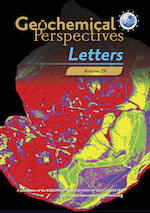4.46 Ga zircons anchor chronology of lunar magma ocean
Affiliations | Corresponding Author | Cite as | Funding information- Share this article





-
Article views:762Cumulative count of HTML views and PDF downloads.
- Download Citation
- Rights & Permissions
top
Abstract
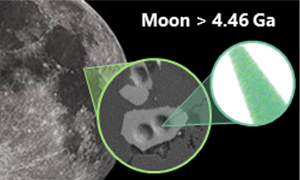
Zhang, B., Lin, Y., Moser, D.E., Hao, J., Liu, Y., Zhang, J., Barker, I.R., Li, Q., Shieh, S.R., Bouvier, A. (2021) Radiogenic Pb mobilization induced by shock metamorphism of zircons in the Apollo 72255 Civet Cat norite clast. Geochimica et Cosmochimica Acta 302, 175–192. https://doi.org/10.1016/j.gca.2021.03.012
), the oldest lunar zircon yet reported. To assess the possible mobility of radiogenic lead in zircon, which may lead to redistribution and clustering of Pb atoms that may cause a U-Pb age bias (Valley et al., 2014Valley, J.W., Cavosie, A.J., Ushikubo, T., Reinhard, D.A., Lawrence, D.F., Larson, D.J., Clifton, P.H., Kelly, T.F., Wilde, S.A., Moser, D.E., Spicuzza, M.J. (2014) Hadean age for a post-magma-ocean zircon confirmed by atom-probe tomography. Nature Geoscience 7, 219–223. https://doi.org/10.1038/ngeo2075
), we investigated a zircon grain from Zhang et al. (2021)Zhang, B., Lin, Y., Moser, D.E., Hao, J., Liu, Y., Zhang, J., Barker, I.R., Li, Q., Shieh, S.R., Bouvier, A. (2021) Radiogenic Pb mobilization induced by shock metamorphism of zircons in the Apollo 72255 Civet Cat norite clast. Geochimica et Cosmochimica Acta 302, 175–192. https://doi.org/10.1016/j.gca.2021.03.012
by atom probe tomography (APT). The atomic spatial resolution analysis of individual mineral grains demonstrates the absence of nanoscale clustering of lead, which supports a 4.46 Ga ancient formation age for lunar zircon in sample 72255. This age pushes back the age of the first preserved lunar crust by ∼40 Myr and provides a minimum formation age for the Moon within 110 Myr after the formation of the solar system.Figures
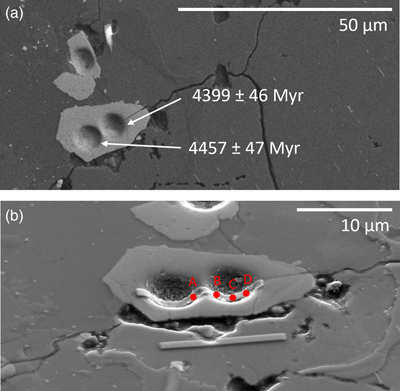 Figure 1 Secondary electron images of zircon Z14. a) Top-down image showing SIMS pits, b) image tilted at 55°, showing zircon with Pt deposit to be lifted out. The approximate positions of the sampling locations (A to D shown in red) for the successful APT runs are labelled. Scale bars shown. | 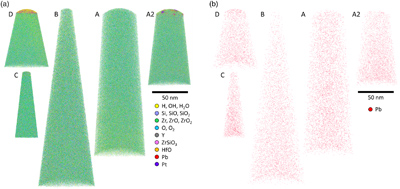 Figure 2 APT reconstructions of the nanotips. a) Shows the major ionic species present, with each ion identified as an individual point and colour coded, and b) shows just 208Pb++ in red. | 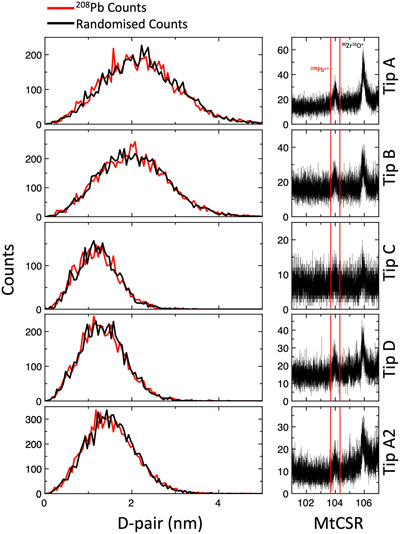 Figure 3 Nearest neighbour distribution of 208Pb for all analysed tomographic datasets. To the left are the distributions of Pb atoms (shown as distance between pairs; D-pair) in the sample (red) and randomised distributions (black). On the right are plots of mass spectra of each of the 5 datasets for the mass-to-charge-state ratio (MtCSR) range around 208Pb2+. The red dashed lines define the range of the Pb peak that was included in the nearest neighbour calculation. | 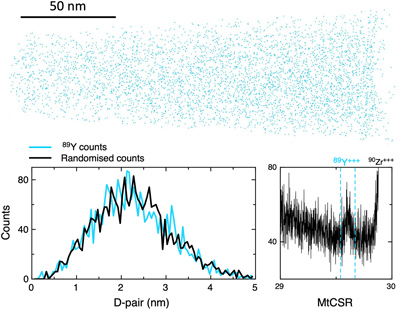 Figure 4 Reconstruction and nearest neighbour distribution of Y (shown as distance between pairs; D-pair) for Tip A. The top image shows the 89Y3+ ions’ individual points in blue. To the bottom left are the distributions of Y atoms in the sample (plotted in light blue) and randomised distribution (plotted in black). To the bottom right is a plot of the mass-to-charge-state ratio (MtCSR) at the range around 89Y3+. The blue dashed line defines the range of the Pb peak that was included in the nearest neighbour calculation. |
| Figure 1 | Figure 2 | Figure 3 | Figure 4 |
top
Introduction
The leading hypothesis for the formation of the Earth–Moon system is the Giant Impact hypothesis where a Mars-sized object collided with the growing proto-Earth (Cameron and Ward, 1976
Cameron, A.G.W., Ward, W.R. (1976) The origin of the Moon. Lunar and Planetary Science Conference 7, 120.
; Canup, 2004Canup, R.M. (2004) Dynamics of lunar formation. Annual Review of Astronomy and Astrophysics 42, 441–475. https://doi.org/10.1146/annurev.astro.41.082201.113457
), which may have resulted in a globally molten Moon known as the lunar magma ocean (LMO; Wood et al., 1970Wood, J.A., Dickey, J.S., Jr., Marvin, U.B., Powell, B.N. (1970) Lunar anorthosites and a geophysical model of the moon. Proceedings of the Apollo 11 Lunar Science Conference 1, 965–988.
; Warren, 1985Warren, P.H. (1985) The magma ocean concept and lunar evolution. Annual Review of Earth and Planetary Sciences 13, 201–240. https://doi.org/10.1146/annurev.ea.13.050185.001221
). The LMO model explains the proposed structure of the lunar interior, with dense mafic materials forming the mantle (the source of mare basalts), ferroan anorthosite forming the crust, and a residual liquid with high concentrations of incompatible elements potassium, rare-earth elements, and phosphorus (KREEP) crystallising between the two (Warren, 1985Warren, P.H. (1985) The magma ocean concept and lunar evolution. Annual Review of Earth and Planetary Sciences 13, 201–240. https://doi.org/10.1146/annurev.ea.13.050185.001221
). The density difference between some crustal materials (ilmenite-bearing cumulates) and mantle materials caused a so-called mantle overturn, which allowed magmas to intrude the anorthositic crust forming the plutonic Mg-suite rocks (Shearer et al., 2015Shearer, C.K., Elardo, S.M., Petro, N.E., Borg, L.E., McCubbin, F.M. (2015) Origin of the lunar highlands Mg-suite: An integrated petrology, geochemistry, chronology, and remote sensing perspective. American Mineralogist 100, 294–325. https://doi.org/10.2138/am-2015-4817
).The timing of the Giant Impact and LMO crystallisation is debated (Borg et al., 2015
Borg, L.E., Gaffney, A.M., Shearer. C.K. (2015) A review of lunar chronology revealing a preponderance of 4.34–4.37 Ga ages. Meteoritics and Planetary Science 50, 715–732. https://doi.org/10.1111/maps.12373
). The 182Hf-182W radiogenic systematics (Thiemens et al., 2019Thiemens, M.M., Sprung, P., Fonseca, R.O.C., Leitzke, F.P., Münker, C. (2019) Early Moon formation inferred from hafnium–tungsten systematics. Nature Geoscience 12, 696–700. https://doi.org/10.1038/s41561-019-0398-3
), Hf model ages of lunar zircons (Barboni et al., 2017Barboni, M., Boehnke, P., Keller, B., Kohl, I.E., Schoene, B., Young, E.D., McKeegan, K.D. (2017) Early formation of the Moon 4.51 billion years ago. Science Advances 3. https://doi.org/10.1126/sciadv.1602365
), and dynamical modelling (Bottke et al., 2015Bottke, W.F., Vokrouhlicky, D., Marchi, S., Swindle, T., Scott, E.R.D., Weirich, J.R., Levison, H. (2015) Dating the Moon-forming impact event with asteroidal meteorites. Science 348, 321–323. https://doi.org/10.1126/science.aaa0602
) place the Moon-forming event early in the solar system’s history, between 4.52 to 4.47 Ga. In contrast, lunar Pb model ages (Connelly and Bizzarro, 2016Connelly, J.N., Bizzarro, M. (2016) Lead isotope evidence for a young formation age of the Earth–Moon system. Earth and Planetary Science Letters 452, 36–43. https://doi.org/10.1016/j.epsl.2016.07.010
) and thermal modelling (Maurice et al., 2020Maurice, M., Tosi, N., Schwinger, S., Breuer, D., Kleine, T. (2020) A long-lived magma ocean on a young Moon. Science advances 6. https://doi.org/10.1126/sciadv.aba8949
) place it in the range of 4.43 to 4.42 Ga. A precise lower age limit for LMO crystallisation is given in Nemchin et al. (2009)Nemchin, A., Timms, N., Pidgeon, R., Geisler, T., Reddy, S., Meyer, C. (2009) Timing of crystallization of the lunar magma ocean constrained by the oldest zircon. Nature Geoscience 2, 133–136. https://doi.org/10.1038/ngeo417
, which reported a 207Pb/206Pb date of 4417 ± 6 Ma measured by sensitive high-resolution ion microprobe (SHRIMP) for a zircon grain from the Apollo impact melt breccia 72215. Later Giant Impact and LMO crystallisation are favoured by the concordant formation of the source of mare basalts, selected ferroan anorthosites, Mg-suite rocks, and zircons (primarily derived from the Mg-suite) at ∼4.3 Ga (Borg et al., 2015Borg, L.E., Gaffney, A.M., Shearer. C.K. (2015) A review of lunar chronology revealing a preponderance of 4.34–4.37 Ga ages. Meteoritics and Planetary Science 50, 715–732. https://doi.org/10.1111/maps.12373
).The vast majority of lunar zircon crystallisation was likely part of, or post-dated, the urKREEP – the primordial KREEP component – because of the enrichment in incompatible elements (those remaining in the melt until the last rock suite is solidified) needed to form this mineral (e.g., Warren and Wasson, 1979
Warren, P.H., Wasson, J.T. (1979) The origin of KREEP. Reviews of Geophysics 17, 73–88. https://doi.org/10.1029/RG017i001p00073
), and therefore occurred at, and after, the late stage of the LMO crystallisation. The U-Pb system in zircon is a particularly robust chronometer, as zircon readily incorporates U and excludes Pb from crystal lattices, and zircon is a refractory mineral both structurally and geochemically resistant to post-crystallisation thermal alteration (Finch and Hanchar, 2003Finch, R.J., Hanchar. J.M. (2003) Structure and chemistry of zircon and zircon-group minerals. Reviews in mineralogy and geochemistry 53, 1–25. https://doi.org/10.1515/9781501509322-004
). The U-Pb chronology of the oldest lunar zircon would thus provide constraints on the LMO crystallisation and the minimum timing of the Giant Impact.Zhang et al. (2021)
Zhang, B., Lin, Y., Moser, D.E., Hao, J., Liu, Y., Zhang, J., Barker, I.R., Li, Q., Shieh, S.R., Bouvier, A. (2021) Radiogenic Pb mobilization induced by shock metamorphism of zircons in the Apollo 72255 Civet Cat norite clast. Geochimica et Cosmochimica Acta 302, 175–192. https://doi.org/10.1016/j.gca.2021.03.012
reported the U-Pb isotopic composition of 21 zircon grains measured with nanoscale secondary ionisation mass spectrometry (NanoSIMS) on a total of 42 spots in the Apollo 17 72255 Civet Cat norite clast (Meyer, 2009Meyer, C. (2009) Lunar Sample Compendium. Astromaterials Research & Exploration Science, National Aeronautics and Space Administration, https://curator.jsc.nasa.gov/lunar/lsc/.
). The euhedral and subhedral zircon grains in this sample are small (10 to 25 μm in length; Fig. 1). The oldest six spots on these zircon grains have a concordant U-Pb average date of 4460 ± 31 Ma and define a weighted mean 207Pb/206Pb date of 4453 ± 34 Ma (all 2σ uncertainties). These dates have the potential to constrain the lower limit of the timing of the Giant Impact and LMO crystallisation at 4460 Ma. These ancient zircon dates reported by Zhang et al. (2021)Zhang, B., Lin, Y., Moser, D.E., Hao, J., Liu, Y., Zhang, J., Barker, I.R., Li, Q., Shieh, S.R., Bouvier, A. (2021) Radiogenic Pb mobilization induced by shock metamorphism of zircons in the Apollo 72255 Civet Cat norite clast. Geochimica et Cosmochimica Acta 302, 175–192. https://doi.org/10.1016/j.gca.2021.03.012
could result either from unsupported Pb clusters caused by radiogenic Pb mobilisation or from Pb-retention domains that survived normal Pb loss. In the former scenario, radiogenic Pb mobilisation could compromise the authenticity of zircon U-Pb dates (Kusiak et al., 2013aKusiak, M.A., Whitehouse, M.J., Wilde, S.A., Dunkley, D.J., Menneken, M., Nemchin, A.A., Clark, C. (2013a) Changes in zircon chemistry during Archean UHT metamorphism in the Napier Complex, Antarctica. American Journal of Science 313, 933–967. https://doi.org/10.2475/09.2013.05
,bKusiak, M.A., Whitehouse, M.J., Wilde, S.A., Nemchin, A.A., Clark C. (2013b) Mobilization of radiogenic Pb in zircon revealed by ion imaging: Implications for early Earth geochronology. Geology 41, 291–294. https://doi.org/10.1130/G33920.1
; Ge et al., 2019Ge, R., Wilde, S.A., Nemchin, A.A., Whitehouse, M.J., Bellucci, J.J., Erickson, T.M. (2019) Mechanisms and consequences of intra-crystalline enrichment of ancient radiogenic Pb in detrital Hadean zircons from the Jack Hills, Western Australia. Earth and Planetary Science Letters 517, 38–49. https://doi.org/10.1016/j.epsl.2019.04.005
), while in the latter, the widespread U-Pb dates of the Civet Cat norite zircons are due to normal Pb loss in some of the crystal domains (Arcuri et al., 2020Arcuri, G.A., Moser, D.E., Reinhard, D.A., Langelier, B., Larson, D.J. (2020) Impact-triggered nanoscale Pb clustering and Pb loss domains in Archean zircon. Contributions to Mineralogy and Petrology 175, 1–13. https://doi.org/10.1007/s00410-020-01698-w
).
Figure 1 Secondary electron images of zircon Z14. a) Top-down image showing SIMS pits, b) image tilted at 55°, showing zircon with Pt deposit to be lifted out. The approximate positions of the sampling locations (A to D shown in red) for the successful APT runs are labelled. Scale bars shown.
top
Methods
We used atom-probe tomography (APT), a time-of-flight mass spectrometry method with nanoscale spatial resolution, to investigate the Pb spatial distribution within an old lunar zircon domain to test if the ancient zircon dates in the Civet Cat norite obtained by Zhang et al. (2021)
Zhang, B., Lin, Y., Moser, D.E., Hao, J., Liu, Y., Zhang, J., Barker, I.R., Li, Q., Shieh, S.R., Bouvier, A. (2021) Radiogenic Pb mobilization induced by shock metamorphism of zircons in the Apollo 72255 Civet Cat norite clast. Geochimica et Cosmochimica Acta 302, 175–192. https://doi.org/10.1016/j.gca.2021.03.012
are authentic or potentially affected by nanoscale redistribution and clustering processes. Because zircon Z14 (207Pb/206Pb date = 4453 ± 34 Ma, Th/U ≈ 7.2) has one of the six oldest domains in the Civet Cat norite, we selected it for APT analysis to investigate its Pb distribution at the nanoscale. During APT analyses, surface atoms of a sample nanotip are field-evaporated in a high electric field thermally activated by picosecond laser pulses and analysed with a position-sensitive time-of-flight mass spectrometer, yielding 3-D atom-by-atom distributions of elements and their isotopes with nanoscale spatial resolution (Fig. 2).
Figure 2 APT reconstructions of the nanotips. a) Shows the major ionic species present, with each ion identified as an individual point and colour coded, and b) shows just 208Pb++ in red.
APT has been used in conjunction with secondary ion mass spectrometry (SIMS) to investigate Pb mobility at the nanoscale and reliably date 4.4 Ga Hadean zircon from Jack Hills (Valley et al., 2014
Valley, J.W., Cavosie, A.J., Ushikubo, T., Reinhard, D.A., Lawrence, D.F., Larson, D.J., Clifton, P.H., Kelly, T.F., Wilde, S.A., Moser, D.E., Spicuzza, M.J. (2014) Hadean age for a post-magma-ocean zircon confirmed by atom-probe tomography. Nature Geoscience 7, 219–223. https://doi.org/10.1038/ngeo2075
; Valley et al., 2015Valley, J.W., Reinhard, D.A., Cavosie, A.J., Ushikubo, T., Lawrence, D.F., Larson, D.J., Kelly, T.F., Snoeyenbos, D.R., Strickland, A. (2015) Nano-and micro-geochronology in Hadean and Archean zircons by atom-probe tomography and SIMS: New tools for old minerals. American Mineralogist 100, 1355–1377. https://doi.org/10.2138/am-2015-5134
) and 3.8 Ga Archean zircons from Beartooth Mountains (Blum et al., 2018Blum, T.B., Reinhard, D.A., Chen, Y. Prosa, T.J., Larson, D.J., Valley, J.W. (2018) Uncertainty and sensitivity analysis for spatial and spectral processing of Pb isotopes in zircon by atom probe tomography. In: Moser, D.E., Corfu, F., Darling, J.R., Reddy, S.M., Tait, K. (Eds.) Microstructural Geochronology: Planetary Records Down to Atom Scale, American Geophysical Union, 327–350. https://doi.org/10.1002/9781119227250.ch16
); other studies have used APT to look at lunar Pb-bearing minerals (i.e. Blum et al., 2019Blum, T.B., Reinhard, D.A., Coble, M.A., Spicuzza, M.J., Chen, Y., Cavosie, A.J., Nasdala, L., Chanmuang, C., Prosa, T.J., Larson, D.J., Valley, J.W. (2019) A Nanoscale Record of Impact-Induced Pb Mobility in Lunar Zircon. Microscopy and Microanalysis 25, 2448–2449. https://doi.org/10.1017/S1431927619012972
; White et al., 2019White, L.F., Moser, D.E., Tait, K.T., Langelier, B., Barker, I., Darling, J.R. (2019) Crystallization and impact history of a meteoritic sample of early lunar crust (NWA 3163) refined by atom probe geochronology. Geoscience Frontiers 10, 1841–1848. https://doi.org/10.1016/j.gsf.2018.11.005
). Valley et al. (2014)Valley, J.W., Cavosie, A.J., Ushikubo, T., Reinhard, D.A., Lawrence, D.F., Larson, D.J., Clifton, P.H., Kelly, T.F., Wilde, S.A., Moser, D.E., Spicuzza, M.J. (2014) Hadean age for a post-magma-ocean zircon confirmed by atom-probe tomography. Nature Geoscience 7, 219–223. https://doi.org/10.1038/ngeo2075
demonstrated that nanoscale Pb clustering is associated with Y clustering, which is the result of the enrichment of less compatible elements after the formation of the zircon given sufficient atomic mobility. The Pb clusters detected in these samples, while demonstrating heterogeneity in Pb distribution, are much smaller than the size of the SIMS pit used to date the zircon (clusters are ∼10 nm in diameter whereas pits produced by the SIMS primary beam have diameters of 5 to 10s of μm) and are therefore homogenous when averaged over the scale of the SIMS analysis. APT has several orders of magnitude greater spatial resolution (near-atomic) than the previous analyses of this zircon using NanoSIMS, which for this analysis produced a pit size of a few μm across to analyse a statistically significant number of atoms to produce a date.Details on the sample preparation methods and analytical conditions can be found in the supplementary information.
top
Results
A total of five nanotips were successfully produced from a lamella of zircon Z14 lifted out of two pits (Fig. 1, Fig. S-1) produced by NanoSIMS analyses. The nanotips were shaped to sample a volume immediately adjacent to the material analysed by NanoSIMS, and as to not include material that had been amorphised due to the primary ion beam damage created by the NanoSIMS, the nanotips were instead extracted from a depth of several hundreds of nanometres beneath the analysed surface. Species that were detected in APT include the major elements in zircon (Zr, Si, O), Y, Hf, Pb, Th, H, and oxide/hydride molecular ions (Fig. 2, Fig. S-2). The only isotope of Pb detected above background is 208Pb2+, which can be used as a proxy for all Pb radiogenic isotopes as they are expected to exhibit the same chemical behaviour during secondary alteration processes such as shock metamorphism (e.g., Deutsch and Schärer, 1990
Deutsch, A., Schärer, U. (1990) Isotope systematics and shock-wave metamorphism: I. U-Pb in zircon, titanite and monazite, shocked experimentally up to 59 GPa. Geochimica et Cosmochimica Acta 54, 3427–3434. https://doi.org/10.1016/0016-7037(90)90295-V
). In the 3D tomographic reconstructions of the datasets, we found no evidence of clustering of Pb, Y, or any other elements. We used the nearest neighbour distribution analysis (Stephenson et al., 2007Stephenson, L.T., Moody, M.P., Liddicoat, P.V., Ringer, S.P. (2007) New techniques for the analysis of fine-scaled clustering phenomena within atom probe tomography (APT) data. Microscopy and Microanalysis 13, 448–463. https://doi.org/10.1017/S1431927607070900
), one of the most robust ways to assess heterogeneity in concentration, including clustering. In the nearest neighbour analysis, each Pb atom was examined for the closest distance to the next Pb atom, and the frequency distribution of the distances was plotted (red, Fig. 3). This was then compared to a randomised distribution of points (black, Fig. 3) with the same volume concentration as in the dataset. This method is very sensitive to any type of inhomogeneity as concentration gradients would cause broadening of the distributions (Stephenson et al., 2007Stephenson, L.T., Moody, M.P., Liddicoat, P.V., Ringer, S.P. (2007) New techniques for the analysis of fine-scaled clustering phenomena within atom probe tomography (APT) data. Microscopy and Microanalysis 13, 448–463. https://doi.org/10.1017/S1431927607070900
).
Figure 3 Nearest neighbour distribution of 208Pb for all analysed tomographic datasets. To the left are the distributions of Pb atoms (shown as distance between pairs; D-pair) in the sample (red) and randomised distributions (black). On the right are plots of mass spectra of each of the 5 datasets for the mass-to-charge-state ratio (MtCSR) range around 208Pb2+. The red dashed lines define the range of the Pb peak that was included in the nearest neighbour calculation.
top
Validating the Oldest Lunar Zircon Age
All datasets had prominent 104 Da peaks (208Pb2+) above background. There is an isobaric overlap at 104 Da with 28Si216O3+. However, other peaks associated with this molecular ion (e.g., 28Si29Si16O3+ at 105 Da) in the terrestrial/lunar abundance pattern are not present. Instead, the isotopic pattern of 105–110 Da matches that of the distribution of Zr16O2+ molecular species, which does not overlap with the 104 Da peak. Therefore, we conclude that the 104 Da peak is 208Pb2+. Even in hypothetical samples where the peak at 104 Da would represent the combined concentration of 208Pb2+ and 28Si216O3+, any Pb clustering, if present, would be observable in the dataset from the combined peak if the Pb signal which contributes to the 104 Da peak is above background. Additionally, we determined our method is robust and not sensitive to the peak brackets or windows (referred to as the peak ranges in APT), for which Pb abundances are determined; ranging does not affect the result of the nearest neighbour distribution and clustering (Fig. S-3).
Valley et al. (2015)
Valley, J.W., Reinhard, D.A., Cavosie, A.J., Ushikubo, T., Lawrence, D.F., Larson, D.J., Kelly, T.F., Snoeyenbos, D.R., Strickland, A. (2015) Nano-and micro-geochronology in Hadean and Archean zircons by atom-probe tomography and SIMS: New tools for old minerals. American Mineralogist 100, 1355–1377. https://doi.org/10.2138/am-2015-5134
reported correlated clustering for both the Pb and Y distributions. The most prominent Y peak occurs at 29.67 Da, corresponding to 89Y3+. While only Tip A has this Y peak above background (Fig. S-4), there are no major overlaps at this position, so this determination is unambiguous. In Valley et al. (2015)Valley, J.W., Reinhard, D.A., Cavosie, A.J., Ushikubo, T., Lawrence, D.F., Larson, D.J., Kelly, T.F., Snoeyenbos, D.R., Strickland, A. (2015) Nano-and micro-geochronology in Hadean and Archean zircons by atom-probe tomography and SIMS: New tools for old minerals. American Mineralogist 100, 1355–1377. https://doi.org/10.2138/am-2015-5134
, the Y clusters were more prominent than the Pb clusters and thus can be used as a proxy when Pb concentration is low. In addition, even if 28Si216O3+ significantly contributes to the signal at 104 Da, the absence of Y clusters (Fig. 4) at the overlap-free 29.67 Da peak implies that there is no Pb clustering, thus demonstrating that the zircon is homogenous on the nanoscale for all detected species. While the absence of clustering in one dataset may suggest a larger inter-cluster distance compared to the sampled volume, it is noteworthy that none of the sampled volumes display any clusters (Fig. 3). This observation remains consistent even when the volumes are separated by distances of 1–2 μm, indicating the absence of nanoscale clustering within the analysed domain of this zircon (a volume that spans ∼7 μm across the zircon and comprises a total analysed volume of ∼1 μm in length, larger than the NanoSIMS spot size of ∼5 μm).
Figure 4 Reconstruction and nearest neighbour distribution of Y (shown as distance between pairs; D-pair) for Tip A. The top image shows the 89Y3+ ions’ individual points in blue. To the bottom left are the distributions of Y atoms in the sample (plotted in light blue) and randomised distribution (plotted in black). To the bottom right is a plot of the mass-to-charge-state ratio (MtCSR) at the range around 89Y3+. The blue dashed line defines the range of the Pb peak that was included in the nearest neighbour calculation.
There are heterogeneities in the Pb distribution at the microscale, as shown by Zhang et al. (2021)
Zhang, B., Lin, Y., Moser, D.E., Hao, J., Liu, Y., Zhang, J., Barker, I.R., Li, Q., Shieh, S.R., Bouvier, A. (2021) Radiogenic Pb mobilization induced by shock metamorphism of zircons in the Apollo 72255 Civet Cat norite clast. Geochimica et Cosmochimica Acta 302, 175–192. https://doi.org/10.1016/j.gca.2021.03.012
; however, this cannot be due to the mixing of Pb nanoclusters. NanoSIMS analyses that report younger dates sampled domains with Pb-loss which occurred post-crystallisation, while the oldest dates sampled domains where radiogenic Pb was retained. The other explanation for these ancient dates, the presence of clusters of radiogenic Pb due to mobilisation, is ruled out by our APT analyses. We conclude that the weighted average date of 4460 ± 31 Ma (2σ) obtained for these zircons corresponds to its crystallisation age. Therefore, the minimum formation age of this old zircon population is the oldest evidence found to date for lunar zircon crystallisation.top
Anchoring the Age of the Moon
Lunar silicate samples show 182W excesses due to the decay of 182Hf (with a half-life of ∼8.9 Myr), and because of this, the Moon should have formed at ∼4.51 Ga (Thiemens et al., 2019
Thiemens, M.M., Sprung, P., Fonseca, R.O.C., Leitzke, F.P., Münker, C. (2019) Early Moon formation inferred from hafnium–tungsten systematics. Nature Geoscience 12, 696–700. https://doi.org/10.1038/s41561-019-0398-3
). Thermal modelling by Elkins-Tanton et al. (2011)Elkins-Tanton, L.T., Burgess, S., Yin, Q.-Z. (2011) The lunar magma ocean: Reconciling the solidification process with lunar petrology and geochronology. Earth and Planetary Science Letters 304, 326–336. https://doi.org/10.1016/j.epsl.2011.02.004
suggests that lunar differentiation took place rapidly, with 80 vol. % of the LMO solidified within thousands of years. With this timeframe, the Civet Cat norite zircon age (4.46 Ga) given by Zhang et al. (2021)Zhang, B., Lin, Y., Moser, D.E., Hao, J., Liu, Y., Zhang, J., Barker, I.R., Li, Q., Shieh, S.R., Bouvier, A. (2021) Radiogenic Pb mobilization induced by shock metamorphism of zircons in the Apollo 72255 Civet Cat norite clast. Geochimica et Cosmochimica Acta 302, 175–192. https://doi.org/10.1016/j.gca.2021.03.012
is a strong indication that the LMO had largely solidified by then. The 207Pb/206Pb date of the zircon (4.42 Ga) from Apollo 72215 likely points to the formation of the evolved, late-forming alkali suite in the lunar crust (Nemchin et al., 2009Nemchin, A., Timms, N., Pidgeon, R., Geisler, T., Reddy, S., Meyer, C. (2009) Timing of crystallization of the lunar magma ocean constrained by the oldest zircon. Nature Geoscience 2, 133–136. https://doi.org/10.1038/ngeo417
). The concordant formation ages for the source of mare basalts, some ferroan anorthosites and Mg-suite rocks, and numerous zircons at ∼4.3 Ga may mark a secondary large-scale event on the near side of the Moon. Subsequent bombardment events reworked or melted the earliest crust, modifying parts of the Civet Cat norite zircons, while pristine domains were preserved. The significance of the 4.46 Ga age holds on the preservation of domains within a grain despite post-crystallisation processes; such preservation is demonstrated by nanoscale analyses.These findings require pushing the timing of the solidification of the lunar crust to within at least the first 100 Myr of the formation of the solar system and provide a minimum age for the Giant Impact event that formed the Earth-Moon system. Together with 182Hf-182W isotopic evidence that the core-mantle differentiation of the Moon occurred ∼50 Myr after the formation of the solar system (Thiemens et al., 2019
Thiemens, M.M., Sprung, P., Fonseca, R.O.C., Leitzke, F.P., Münker, C. (2019) Early Moon formation inferred from hafnium–tungsten systematics. Nature Geoscience 12, 696–700. https://doi.org/10.1038/s41561-019-0398-3
), we can now place an age bracket on the timing of the Giant Impact, subsequent LMO crystallisation and the onset of Mg-suite magmatism to between 4.51 and 4.46 Ga. This serves as an anchoring age interval for the onset of the intense gravitational effects that the early, much closer Moon had on the young Earth, as well as when the Moon began recording a history of bombardments.top
Acknowledgements
We are indebted to the NASA Apollo program and astronauts for collecting the samples, and to Ryan Zeigler and the curation team of NASA Johnson Space Center for allocating the lunar samples used in this research. JG acknowledges funding from the Field Museum’s Women’s Board Women in Science Graduate Fellowship. PRH acknowledges funding from the TAWANI Foundation. BZ’s work is supported by NASA grants
Editor: Romain Tartèse
top
References
Arcuri, G.A., Moser, D.E., Reinhard, D.A., Langelier, B., Larson, D.J. (2020) Impact-triggered nanoscale Pb clustering and Pb loss domains in Archean zircon. Contributions to Mineralogy and Petrology 175, 1–13. https://doi.org/10.1007/s00410-020-01698-w
 Show in context
Show in context In the former scenario, radiogenic Pb mobilisation could compromise the authenticity of zircon U-Pb dates (Kusiak et al., 2013a,b; Ge et al., 2019), while in the latter, the widespread U-Pb dates of the Civet Cat norite zircons are due to normal Pb loss in some of the crystal domains (Arcuri et al., 2020).
View in article
Barboni, M., Boehnke, P., Keller, B., Kohl, I.E., Schoene, B., Young, E.D., McKeegan, K.D. (2017) Early formation of the Moon 4.51 billion years ago. Science Advances 3. https://doi.org/10.1126/sciadv.1602365
 Show in context
Show in context The 182Hf-182W radiogenic systematics (Thiemens et al., 2019), Hf model ages of lunar zircons (Barboni et al., 2017), and dynamical modelling (Bottke et al., 2015) place the Moon-forming event early in the solar system’s history, between 4.52 to 4.47 Ga.
View in article
Blum, T.B., Reinhard, D.A., Chen, Y. Prosa, T.J., Larson, D.J., Valley, J.W. (2018) Uncertainty and sensitivity analysis for spatial and spectral processing of Pb isotopes in zircon by atom probe tomography. In: Moser, D.E., Corfu, F., Darling, J.R., Reddy, S.M., Tait, K. (Eds.) Microstructural Geochronology: Planetary Records Down to Atom Scale, American Geophysical Union, 327–350. https://doi.org/10.1002/9781119227250.ch16
 Show in context
Show in context APT has been used in conjunction with secondary ion mass spectrometry (SIMS) to investigate Pb mobility at the nanoscale and reliably date 4.4 Ga Hadean zircon from Jack Hills (Valley et al., 2014; Valley et al., 2015) and 3.8 Ga Archean zircons from Beartooth Mountains (Blum et al., 2018); other studies have used APT to look at lunar Pb-bearing minerals (i.e. Blum et al., 2019; White et al., 2019).
View in article
Blum, T.B., Reinhard, D.A., Coble, M.A., Spicuzza, M.J., Chen, Y., Cavosie, A.J., Nasdala, L., Chanmuang, C., Prosa, T.J., Larson, D.J., Valley, J.W. (2019) A Nanoscale Record of Impact-Induced Pb Mobility in Lunar Zircon. Microscopy and Microanalysis 25, 2448–2449. https://doi.org/10.1017/S1431927619012972
 Show in context
Show in context APT has been used in conjunction with secondary ion mass spectrometry (SIMS) to investigate Pb mobility at the nanoscale and reliably date 4.4 Ga Hadean zircon from Jack Hills (Valley et al., 2014; Valley et al., 2015) and 3.8 Ga Archean zircons from Beartooth Mountains (Blum et al., 2018); other studies have used APT to look at lunar Pb-bearing minerals (i.e. Blum et al., 2019; White et al., 2019).
View in article
Borg, L.E., Gaffney, A.M., Shearer. C.K. (2015) A review of lunar chronology revealing a preponderance of 4.34–4.37 Ga ages. Meteoritics and Planetary Science 50, 715–732. https://doi.org/10.1111/maps.12373
 Show in context
Show in context The timing of the Giant Impact and LMO crystallisation is debated (Borg et al., 2015).
View in article
Later Giant Impact and LMO crystallisation are favoured by the concordant formation of the source of mare basalts, selected ferroan anorthosites, Mg-suite rocks, and zircons (primarily derived from the Mg-suite) at ∼4.3 Ga (Borg et al., 2015).
View in article
Bottke, W.F., Vokrouhlicky, D., Marchi, S., Swindle, T., Scott, E.R.D., Weirich, J.R., Levison, H. (2015) Dating the Moon-forming impact event with asteroidal meteorites. Science 348, 321–323. https://doi.org/10.1126/science.aaa0602
 Show in context
Show in context The 182Hf-182W radiogenic systematics (Thiemens et al., 2019), Hf model ages of lunar zircons (Barboni et al., 2017), and dynamical modelling (Bottke et al., 2015) place the Moon-forming event early in the solar system’s history, between 4.52 to 4.47 Ga.
View in article
Cameron, A.G.W., Ward, W.R. (1976) The origin of the Moon. Lunar and Planetary Science Conference 7, 120.
 Show in context
Show in context The leading hypothesis for the formation of the Earth–Moon system is the Giant Impact hypothesis where a Mars-sized object collided with the growing proto-Earth (Cameron and Ward, 1976; Canup, 2004), which may have resulted in a globally molten Moon known as the lunar magma ocean (LMO; Wood et al., 1970; Warren, 1985).
View in article
Canup, R.M. (2004) Dynamics of lunar formation. Annual Review of Astronomy and Astrophysics 42, 441–475. https://doi.org/10.1146/annurev.astro.41.082201.113457
 Show in context
Show in context The leading hypothesis for the formation of the Earth–Moon system is the Giant Impact hypothesis where a Mars-sized object collided with the growing proto-Earth (Cameron and Ward, 1976; Canup, 2004), which may have resulted in a globally molten Moon known as the lunar magma ocean (LMO; Wood et al., 1970; Warren, 1985).
View in article
Connelly, J.N., Bizzarro, M. (2016) Lead isotope evidence for a young formation age of the Earth–Moon system. Earth and Planetary Science Letters 452, 36–43. https://doi.org/10.1016/j.epsl.2016.07.010
 Show in context
Show in context In contrast, lunar Pb model ages (Connelly and Bizzarro, 2016) and thermal modelling (Maurice et al., 2020) place it in the range of 4.43 to 4.42 Ga. A precise lower age limit for LMO crystallisation is given in Nemchin et al. (2009), which reported a 207Pb/206Pb date of 4417 ± 6 Ma measured by sensitive high-resolution ion microprobe (SHRIMP) for a zircon grain from the Apollo impact melt breccia 72215.
View in article
Deutsch, A., Schärer, U. (1990) Isotope systematics and shock-wave metamorphism: I. U-Pb in zircon, titanite and monazite, shocked experimentally up to 59 GPa. Geochimica et Cosmochimica Acta 54, 3427–3434. https://doi.org/10.1016/0016-7037(90)90295-V
 Show in context
Show in context The only isotope of Pb detected above background is 208Pb2+, which can be used as a proxy for all Pb radiogenic isotopes as they are expected to exhibit the same chemical behaviour during secondary alteration processes such as shock metamorphism (e.g., Deutsch and Schärer, 1990).
View in article
Elkins-Tanton, L.T., Burgess, S., Yin, Q.-Z. (2011) The lunar magma ocean: Reconciling the solidification process with lunar petrology and geochronology. Earth and Planetary Science Letters 304, 326–336. https://doi.org/10.1016/j.epsl.2011.02.004
 Show in context
Show in context Thermal modelling by Elkins-Tanton et al. (2011) suggests that lunar differentiation took place rapidly, with 80 vol. % of the LMO solidified within thousands of years.
View in article
Finch, R.J., Hanchar. J.M. (2003) Structure and chemistry of zircon and zircon-group minerals. Reviews in mineralogy and geochemistry 53, 1–25. https://doi.org/10.1515/9781501509322-004
 Show in context
Show in context The U-Pb system in zircon is a particularly robust chronometer, as zircon readily incorporates U and excludes Pb from crystal lattices, and zircon is a refractory mineral both structurally and geochemically resistant to post-crystallisation thermal alteration (Finch and Hanchar, 2003).
View in article
Ge, R., Wilde, S.A., Nemchin, A.A., Whitehouse, M.J., Bellucci, J.J., Erickson, T.M. (2019) Mechanisms and consequences of intra-crystalline enrichment of ancient radiogenic Pb in detrital Hadean zircons from the Jack Hills, Western Australia. Earth and Planetary Science Letters 517, 38–49. https://doi.org/10.1016/j.epsl.2019.04.005
 Show in context
Show in context In the former scenario, radiogenic Pb mobilisation could compromise the authenticity of zircon U-Pb dates (Kusiak et al., 2013a,b; Ge et al., 2019), while in the latter, the widespread U-Pb dates of the Civet Cat norite zircons are due to normal Pb loss in some of the crystal domains (Arcuri et al., 2020).
View in article
Kusiak, M.A., Whitehouse, M.J., Wilde, S.A., Dunkley, D.J., Menneken, M., Nemchin, A.A., Clark, C. (2013a) Changes in zircon chemistry during Archean UHT metamorphism in the Napier Complex, Antarctica. American Journal of Science 313, 933–967. https://doi.org/10.2475/09.2013.05
 Show in context
Show in context In the former scenario, radiogenic Pb mobilisation could compromise the authenticity of zircon U-Pb dates (Kusiak et al., 2013a,b; Ge et al., 2019), while in the latter, the widespread U-Pb dates of the Civet Cat norite zircons are due to normal Pb loss in some of the crystal domains (Arcuri et al., 2020).
View in article
Kusiak, M.A., Whitehouse, M.J., Wilde, S.A., Nemchin, A.A., Clark C. (2013b) Mobilization of radiogenic Pb in zircon revealed by ion imaging: Implications for early Earth geochronology. Geology 41, 291–294. https://doi.org/10.1130/G33920.1
 Show in context
Show in context In the former scenario, radiogenic Pb mobilisation could compromise the authenticity of zircon U-Pb dates (Kusiak et al., 2013a,b; Ge et al., 2019), while in the latter, the widespread U-Pb dates of the Civet Cat norite zircons are due to normal Pb loss in some of the crystal domains (Arcuri et al., 2020).
View in article
Maurice, M., Tosi, N., Schwinger, S., Breuer, D., Kleine, T. (2020) A long-lived magma ocean on a young Moon. Science advances 6. https://doi.org/10.1126/sciadv.aba8949
 Show in context
Show in context In contrast, lunar Pb model ages (Connelly and Bizzarro, 2016) and thermal modelling (Maurice et al., 2020) place it in the range of 4.43 to 4.42 Ga. A precise lower age limit for LMO crystallisation is given in Nemchin et al. (2009), which reported a 207Pb/206Pb date of 4417 ± 6 Ma measured by sensitive high-resolution ion microprobe (SHRIMP) for a zircon grain from the Apollo impact melt breccia 72215.
View in article
Meyer, C. (2009) Lunar Sample Compendium. Astromaterials Research & Exploration Science, National Aeronautics and Space Administration, https://curator.jsc.nasa.gov/lunar/lsc/.
 Show in context
Show in context Zhang et al. (2021) reported the U-Pb isotopic composition of 21 zircon grains measured with nanoscale secondary ionisation mass spectrometry (NanoSIMS) on a total of 42 spots in the Apollo 17 72255 Civet Cat norite clast (Meyer, 2009).
View in article
Nemchin, A., Timms, N., Pidgeon, R., Geisler, T., Reddy, S., Meyer, C. (2009) Timing of crystallization of the lunar magma ocean constrained by the oldest zircon. Nature Geoscience 2, 133–136. https://doi.org/10.1038/ngeo417
 Show in context
Show in context In contrast, lunar Pb model ages (Connelly and Bizzarro, 2016) and thermal modelling (Maurice et al., 2020) place it in the range of 4.43 to 4.42 Ga. A precise lower age limit for LMO crystallisation is given in Nemchin et al. (2009), which reported a 207Pb/206Pb date of 4417 ± 6 Ma measured by sensitive high-resolution ion microprobe (SHRIMP) for a zircon grain from the Apollo impact melt breccia 72215.
View in article
The 207Pb/206Pb date of the zircon (4.42 Ga) from Apollo 72215 likely points to the formation of the evolved, late-forming alkali suite in the lunar crust (Nemchin et al., 2009).
View in article
Shearer, C.K., Elardo, S.M., Petro, N.E., Borg, L.E., McCubbin, F.M. (2015) Origin of the lunar highlands Mg-suite: An integrated petrology, geochemistry, chronology, and remote sensing perspective. American Mineralogist 100, 294–325. https://doi.org/10.2138/am-2015-4817
 Show in context
Show in context The density difference between some crustal materials (ilmenite-bearing cumulates) and mantle materials caused a so-called mantle overturn, which allowed magmas to intrude the anorthositic crust forming the plutonic Mg-suite rocks (Shearer et al., 2015).
View in article
Stephenson, L.T., Moody, M.P., Liddicoat, P.V., Ringer, S.P. (2007) New techniques for the analysis of fine-scaled clustering phenomena within atom probe tomography (APT) data. Microscopy and Microanalysis 13, 448–463. https://doi.org/10.1017/S1431927607070900
 Show in context
Show in context In the 3D tomographic reconstructions of the datasets, we found no evidence of clustering of Pb, Y, or any other elements. We used the nearest neighbour distribution analysis (Stephenson et al., 2007), one of the most robust ways to assess heterogeneity in concentration, including clustering.
View in article
This was then compared to a randomised distribution of points (black, Fig. 3) with the same volume concentration as in the dataset. This method is very sensitive to any type of inhomogeneity as concentration gradients would cause broadening of the distributions (Stephenson et al., 2007).
View in article
Thiemens, M.M., Sprung, P., Fonseca, R.O.C., Leitzke, F.P., Münker, C. (2019) Early Moon formation inferred from hafnium–tungsten systematics. Nature Geoscience 12, 696–700. https://doi.org/10.1038/s41561-019-0398-3
 Show in context
Show in context The 182Hf-182W radiogenic systematics (Thiemens et al., 2019), Hf model ages of lunar zircons (Barboni et al., 2017), and dynamical modelling (Bottke et al., 2015) place the Moon-forming event early in the solar system’s history, between 4.52 to 4.47 Ga.
View in article
Lunar silicate samples show 182W excesses due to the decay of 182Hf (with a half-life of ∼8.9 Myr), and because of this, the Moon should have formed at ∼4.51 Ga (Thiemens et al., 2019).
View in article
Together with 182Hf-182W isotopic evidence that the core-mantle differentiation of the Moon occurred ∼50 Myr after the formation of the solar system (Thiemens et al., 2019), we can now place an age bracket on the timing of the Giant Impact, subsequent LMO crystallisation and the onset of Mg-suite magmatism to between 4.51 and 4.46 Ga.
View in article
Valley, J.W., Cavosie, A.J., Ushikubo, T., Reinhard, D.A., Lawrence, D.F., Larson, D.J., Clifton, P.H., Kelly, T.F., Wilde, S.A., Moser, D.E., Spicuzza, M.J. (2014) Hadean age for a post-magma-ocean zircon confirmed by atom-probe tomography. Nature Geoscience 7, 219–223. https://doi.org/10.1038/ngeo2075
 Show in context
Show in context To assess the possible mobility of radiogenic lead in zircon, which may lead to redistribution and clustering of Pb atoms that may cause a U-Pb age bias (Valley et al., 2014), we investigated a zircon grain from Zhang et al. (2021) by atom probe tomography (APT).
View in article
APT has been used in conjunction with secondary ion mass spectrometry (SIMS) to investigate Pb mobility at the nanoscale and reliably date 4.4 Ga Hadean zircon from Jack Hills (Valley et al., 2014; Valley et al., 2015) and 3.8 Ga Archean zircons from Beartooth Mountains (Blum et al., 2018); other studies have used APT to look at lunar Pb-bearing minerals (i.e. Blum et al., 2019; White et al., 2019).
View in article
Valley et al. (2014) demonstrated that nanoscale Pb clustering is associated with Y clustering, which is the result of the enrichment of less compatible elements after the formation of the zircon given sufficient atomic mobility.
View in article
Valley, J.W., Reinhard, D.A., Cavosie, A.J., Ushikubo, T., Lawrence, D.F., Larson, D.J., Kelly, T.F., Snoeyenbos, D.R., Strickland, A. (2015) Nano-and micro-geochronology in Hadean and Archean zircons by atom-probe tomography and SIMS: New tools for old minerals. American Mineralogist 100, 1355–1377. https://doi.org/10.2138/am-2015-5134
 Show in context
Show in context APT has been used in conjunction with secondary ion mass spectrometry (SIMS) to investigate Pb mobility at the nanoscale and reliably date 4.4 Ga Hadean zircon from Jack Hills (Valley et al., 2014; Valley et al., 2015) and 3.8 Ga Archean zircons from Beartooth Mountains (Blum et al., 2018); other studies have used APT to look at lunar Pb-bearing minerals (i.e. Blum et al., 2019; White et al., 2019).
View in article
Valley et al. (2015) reported correlated clustering for both the Pb and Y distributions.
View in article
In Valley et al. (2015), the Y clusters were more prominent than the Pb clusters and thus can be used as a proxy when Pb concentration is low.
View in article
Warren, P.H., Wasson, J.T. (1979) The origin of KREEP. Reviews of Geophysics 17, 73–88. https://doi.org/10.1029/RG017i001p00073
 Show in context
Show in context The vast majority of lunar zircon crystallisation was likely part of, or post-dated, the urKREEP – the primordial KREEP component – because of the enrichment in incompatible elements (those remaining in the melt until the last rock suite is solidified) needed to form this mineral (e.g., Warren and Wasson, 1979), and therefore occurred at, and after, the late stage of the LMO crystallisation.
View in article
Warren, P.H. (1985) The magma ocean concept and lunar evolution. Annual Review of Earth and Planetary Sciences 13, 201–240. https://doi.org/10.1146/annurev.ea.13.050185.001221
 Show in context
Show in context The leading hypothesis for the formation of the Earth–Moon system is the Giant Impact hypothesis where a Mars-sized object collided with the growing proto-Earth (Cameron and Ward, 1976; Canup, 2004), which may have resulted in a globally molten Moon known as the lunar magma ocean (LMO; Wood et al., 1970; Warren, 1985).
View in article
The LMO model explains the proposed structure of the lunar interior, with dense mafic materials forming the mantle (the source of mare basalts), ferroan anorthosite forming the crust, and a residual liquid with high concentrations of incompatible elements potassium, rare-earth elements, and phosphorus (KREEP) crystallising between the two (Warren, 1985).
View in article
White, L.F., Moser, D.E., Tait, K.T., Langelier, B., Barker, I., Darling, J.R. (2019) Crystallization and impact history of a meteoritic sample of early lunar crust (NWA 3163) refined by atom probe geochronology. Geoscience Frontiers 10, 1841–1848. https://doi.org/10.1016/j.gsf.2018.11.005
 Show in context
Show in context APT has been used in conjunction with secondary ion mass spectrometry (SIMS) to investigate Pb mobility at the nanoscale and reliably date 4.4 Ga Hadean zircon from Jack Hills (Valley et al., 2014; Valley et al., 2015) and 3.8 Ga Archean zircons from Beartooth Mountains (Blum et al., 2018); other studies have used APT to look at lunar Pb-bearing minerals (i.e. Blum et al., 2019; White et al., 2019).
View in article
Wood, J.A., Dickey, J.S., Jr., Marvin, U.B., Powell, B.N. (1970) Lunar anorthosites and a geophysical model of the moon. Proceedings of the Apollo 11 Lunar Science Conference 1, 965–988.
 Show in context
Show in context The leading hypothesis for the formation of the Earth–Moon system is the Giant Impact hypothesis where a Mars-sized object collided with the growing proto-Earth (Cameron and Ward, 1976; Canup, 2004), which may have resulted in a globally molten Moon known as the lunar magma ocean (LMO; Wood et al., 1970; Warren, 1985).
View in article
Zhang, B., Lin, Y., Moser, D.E., Hao, J., Liu, Y., Zhang, J., Barker, I.R., Li, Q., Shieh, S.R., Bouvier, A. (2021) Radiogenic Pb mobilization induced by shock metamorphism of zircons in the Apollo 72255 Civet Cat norite clast. Geochimica et Cosmochimica Acta 302, 175–192. https://doi.org/10.1016/j.gca.2021.03.012
 Show in context
Show in context The crystallisation ages of lunar samples provide critical constraints on the minimum formation age of the Moon and its early evolution. Zircon crystals from Apollo 17 lunar impact melt breccia 72255 preserve ancient domains with a concordant average uranium-lead radiometric date of 4460 ± 31 Ma (Zhang et al., 2021), the oldest lunar zircon yet reported.
View in article
To assess the possible mobility of radiogenic lead in zircon, which may lead to redistribution and clustering of Pb atoms that may cause a U-Pb age bias (Valley et al., 2014), we investigated a zircon grain from Zhang et al. (2021) by atom probe tomography (APT).
View in article
Zhang et al. (2021) reported the U-Pb isotopic composition of 21 zircon grains measured with nanoscale secondary ionisation mass spectrometry (NanoSIMS) on a total of 42 spots in the Apollo 17 72255 Civet Cat norite clast (Meyer, 2009).
View in article
These ancient zircon dates reported by Zhang et al. (2021) could result either from unsupported Pb clusters caused by radiogenic Pb mobilisation or from Pb-retention domains that survived normal Pb loss.
View in article
We used atom-probe tomography (APT), a time-of-flight mass spectrometry method with nanoscale spatial resolution, to investigate the Pb spatial distribution within an old lunar zircon domain to test if the ancient zircon dates in the Civet Cat norite obtained by Zhang et al. (2021) are authentic or potentially affected by nanoscale redistribution and clustering processes. Because zircon Z14 (207Pb/206Pb date = 4453 ± 34 Ma, Th/U ≈ 7.2) has one of the six oldest domains in the Civet Cat norite, we selected it for APT analysis to investigate its Pb distribution at the nanoscale.
View in article
There are heterogeneities in the Pb distribution at the microscale, as shown by Zhang et al. (2021); however, this cannot be due to the mixing of Pb nanoclusters.
View in article
With this timeframe, the Civet Cat norite zircon age (4.46 Ga) given by Zhang et al. (2021) is a strong indication that the LMO had largely solidified by then.
View in article
top
Supplementary Information
The Supplementary Information includes:
- Methods
- Table S-1
- Figures S-1 to S-4
- Supplementary Information References
Download the Supplementary Information (PDF)
Figures
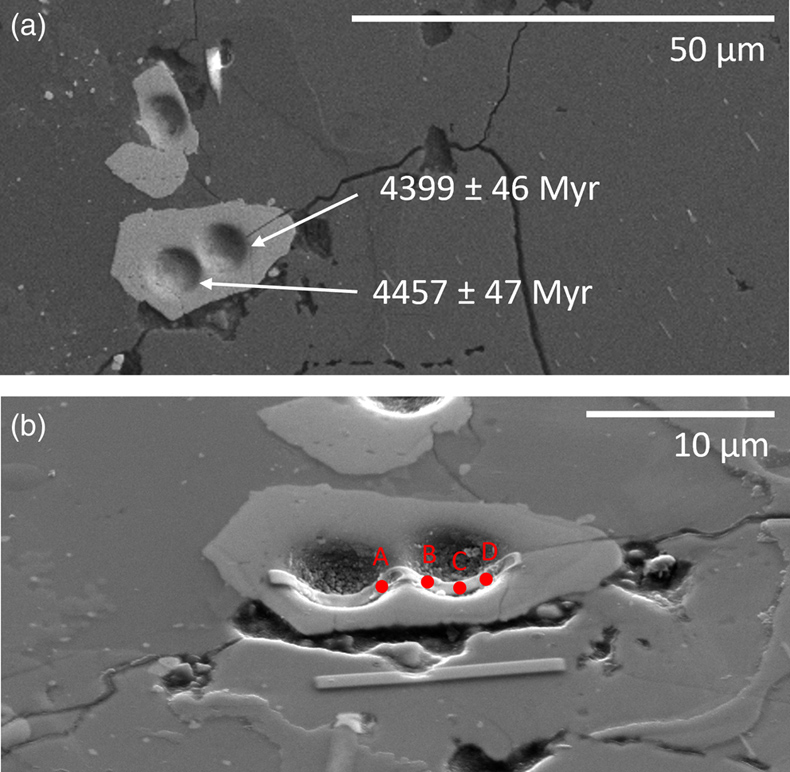
Figure 1 Secondary electron images of zircon Z14. a) Top-down image showing SIMS pits, b) image tilted at 55°, showing zircon with Pt deposit to be lifted out. The approximate positions of the sampling locations (A to D shown in red) for the successful APT runs are labelled. Scale bars shown.
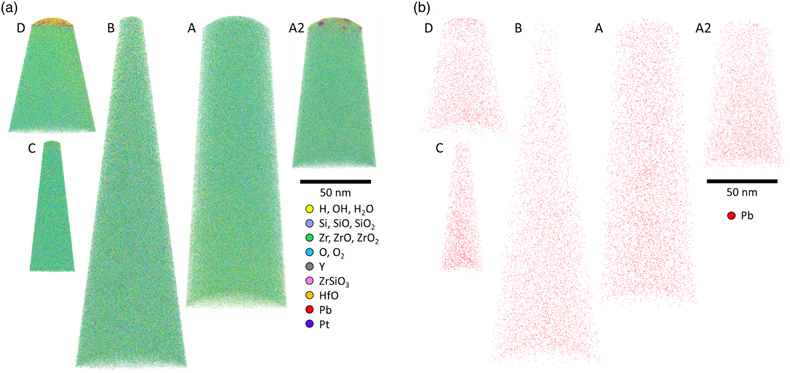
Figure 2 APT reconstructions of the nanotips. a) Shows the major ionic species present, with each ion identified as an individual point and colour coded, and b) shows just 208Pb++ in red.
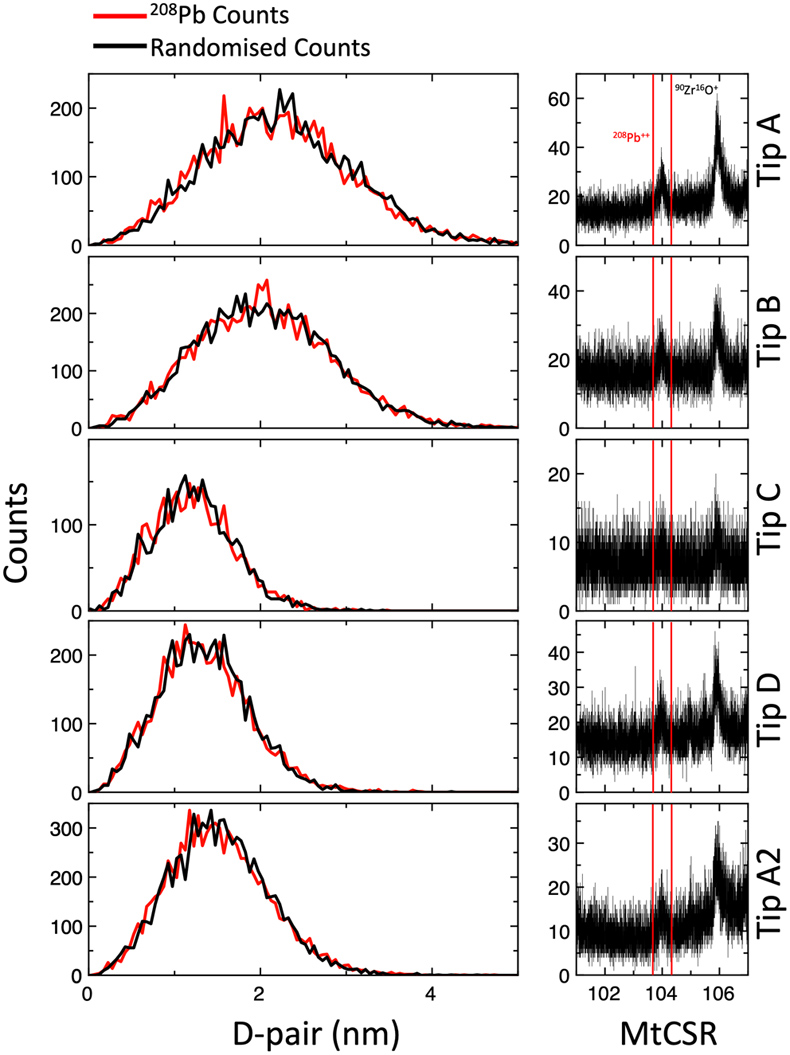
Figure 3 Nearest neighbour distribution of 208Pb for all analysed tomographic datasets. To the left are the distributions of Pb atoms (shown as distance between pairs; D-pair) in the sample (red) and randomised distributions (black). On the right are plots of mass spectra of each of the 5 datasets for the mass-to-charge-state ratio (MtCSR) range around 208Pb2+. The red dashed lines define the range of the Pb peak that was included in the nearest neighbour calculation.
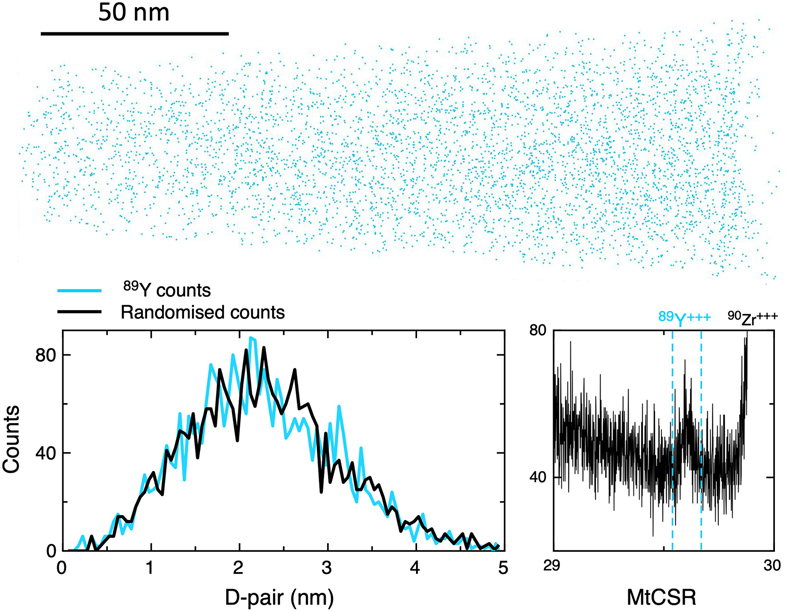
Figure 4 Reconstruction and nearest neighbour distribution of Y (shown as distance between pairs; D-pair) for Tip A. The top image shows the 89Y3+ ions’ individual points in blue. To the bottom left are the distributions of Y atoms in the sample (plotted in light blue) and randomised distribution (plotted in black). To the bottom right is a plot of the mass-to-charge-state ratio (MtCSR) at the range around 89Y3+. The blue dashed line defines the range of the Pb peak that was included in the nearest neighbour calculation.


